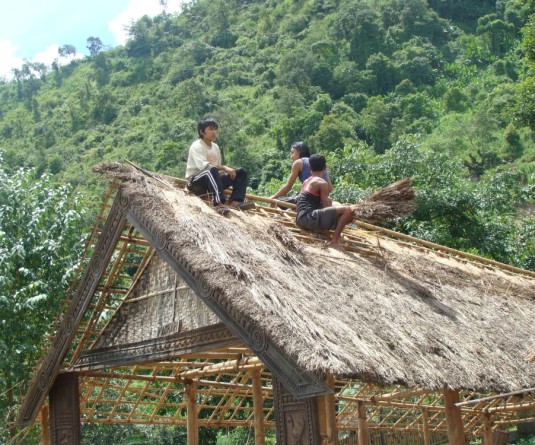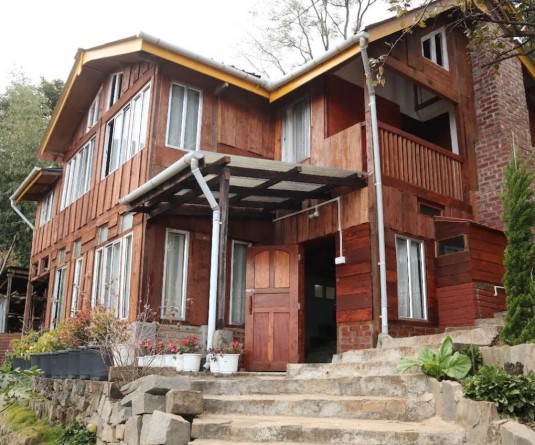Narragansett elder Hiawatha Brown (63) stands tall in front of the Narragansett Indian Longhouse on their reservation in Rhode Island (USA) where important meetings of his people are held. The Longhouse (a sort of Morung) was designed by his mother, the medicine woman. Its construction was completed, with modern finishing, five years back. The crosses on the body of the structure signify the four earthly directions—east, west, north and south. The other symbols denote clans. (Morung Photo)
Elder of the Narragansett people takes The Morung Express to Native American soil
Morung Express Feature
Rhode Island (USA) | August 28
If you walk through some of the indigenous lands in the east of North America, it is, at first, difficult to tell where you are. Dirt tracks through sparse forests lead up to once-in-a-while modern structures. The woods look inhabited by human beings—tree branches have been cut in bits and parts. As you go along, the woods thicken, unseen lakes and springs appear.
“Our people still use firewood stoves at home,” said Hiawatha Brown, 63-year-old elder of the Narragansett people, explaining the partly cut trees. They are the indigenous inhabitants of the lands today called Rhode Island, the Ocean State of the United States of America.
But little else remains of the Narragansett ‘tribal’ lifestyle.
Quasi Sovereignty
A few years ago, when a road construction company was digging up the existing infrastructure to make way for new roads at Jamestown in Rhode Island, they landed up digging through an ancient drainage system of the Narragansett people. Such ancient artefacts, like burial grounds, dot the underbelly of Rhode Island. Their historicity is protected by US Federal laws. However, in the face of development, even after the Narragansett people objected to the destruction of their cultural remains, the road construction continued.
Today, 567 ‘tribes’ are recognised as First Nations in the United States of America, of which 326 live on small patches of native land on which they are granted ‘quasi sovereignty’ on a peculiar colonial structure called the Indian Reservation. Who belongs to a ‘tribe’, or what is protected and destroyed, is decided by the State—“we have to prove to the White People through their system that we are natives,” explained the elder in an exclusive interview with The Morung Express.
Reservations fall under the US Bureau of Indian Affairs (not state governments) and are governed by Tribal Councils, with their own courts and police. Brown is one of nine members of the Narragansett Tribal Council.
He belongs to part turtle and part wolf clans, from a medicine lineage—his mother was a medicine woman. Being from a matriarchal society—“everything belonged to Mother Earth”—each clan among the Narragansett people, once 200 now reduced to 25, inhabited a ‘Longhouse’ or ‘Morung’ in the forests during harsh winter days and moved near the ocean during the summer.
With the coming of a “White People’s Militia” some 500 years ago, almost all of Narragansett land was colonised, either through tax, land grants or simply grabbed and encroached upon. Large numbers of people were killed. Only one and a half acre of Narragansett land (see picture) was never colonised by ‘the White Man.’
In August, the Pow Wow Festival, one among the 13 major festivals marked by 13 cycles of the moon, of the Narragansett people saw them dance and sing on this piece of land paying tribute to their ancestors and the Mother Earth.
Coexistence
On the boundary of the uncolonised (half acre) piece of land stands a church. Brown points at it. “Christianity destroyed our people. It became a tool to control our people and give up everything that we were. That is why I never converted to Christianity,” he asserted, adding that “I resent being called an Indian, or Native American or even American, but we have to adjust in order to co-exist.”
His mother had remained an important figure of the community, later designing a modern Longhouse (see picture) before she died. She even managed to introduce their language to the curriculum of a school nearby, the training in which ended with her death. Brown’s three daughters, however, learnt the language, the rituals as well as cultural songs and dances of the people.
“It is a constant battle for us to keep true to our values,” noted Brown, explaining the circumstances faced by their people today. The Narragansett Reservation occupies about 3200 acres of land spread across Rhode Island. The University of Rhode Island, where Brown spoke at a peace program in June, is a massive property that was “stolen,” he said, from the Narragansett Americans—it is rare for Narragansett youth to get an opportunity to study at either this, or the many high end universities on North American soil that are located on indigenous land grabbed by colonisers centuries ago.
Economic opportunities are also rare to come by. First, Rhode Island is “very racist,” observed the Narragansett elder; a statement affirmed by a few people of colour living in the state or studying at the University of Rhode Island. “80% of those unemployed have their name ending with a vowel,” he remarked, referring to names of people of colour.
Further, Brown narrated that “All economic activities we tried were challenged in some way by the government,” showing us a shuttered down smoke shop they had started. It was forcefully closed by the State citing legality and tax sharing issues. Then, laws, like the Indian Gaming Regulatory Act that provide special provision for Native Americans to make economic progress through such means as organised gambling (casinos), among others, make more trouble than growth for the people.
“Inter tribe problems break out mostly due to economic factors. Vehicles for economic progress drive more greed leading to in-fighting among tribes,” elaborated the elder.
Today, “we have to fight just to maintain our identity,” he lamented of the few thousand people left of his people, struggling to have a semblance of self-determination. It is difficult for them to make it to school—there are no schools on the entire Narragansett Reservation—or even to stay put in the schools given the level of poverty among the people.
“Those who do make it to school and graduate are disoriented and want to change everything that we are. What is the point of this education?” wondered the elder, who worked as a stone mason by day, but was slated to pick strawberries at a farm with little children later on the Sunday that The Morung Express met him.
The Tribal Council is meant to be “an interface” between the old and the young. Brown attempts to play this role to the best of his capability. But it is difficult to “take everyone along.”
Exercising autonomy
As we drive along the few structures on the Reservation—the Longhouse, the deserted smoke shop, a hospital that staffs traditional medicine practitioners as well, an upcoming half-built hospital, an Indian Church—Brown is keen on who the Naga people are, how they live, how their political lives function.
He attends a number of conferences that bring together the Native people of North America to discuss the issues they face and the solutions to move forward. He is interested in the Naga story.
“If you don’t exercise autonomy, you do not have sovereignty. When we stop doing the things we used to do as traditional people, we lose our sovereignty. That is what has happened to us,” reflected Brown on how they were made to give up their sovereignty little at a time. Now, they get to keep their traditional titles, like Sachem (Chief) or medicine (wo)man but their functionality has dimmed. “There is a great change in what it means to be (American) Indian today. We are moving in hundred different directions to defend what we are but we have to learn to shed our warrior attitude,” acknowledged the elder.
Despite the fact that many from the White community in North America continue to believe that the “natives are gone,” Native Americans carry on in some way and their mark remains indelible on American history, even though they have their “feet in two canoes” today.
“We are a memory of where the White Man failed,” said Hiawatha Brown by way of concluding our journey with him.






